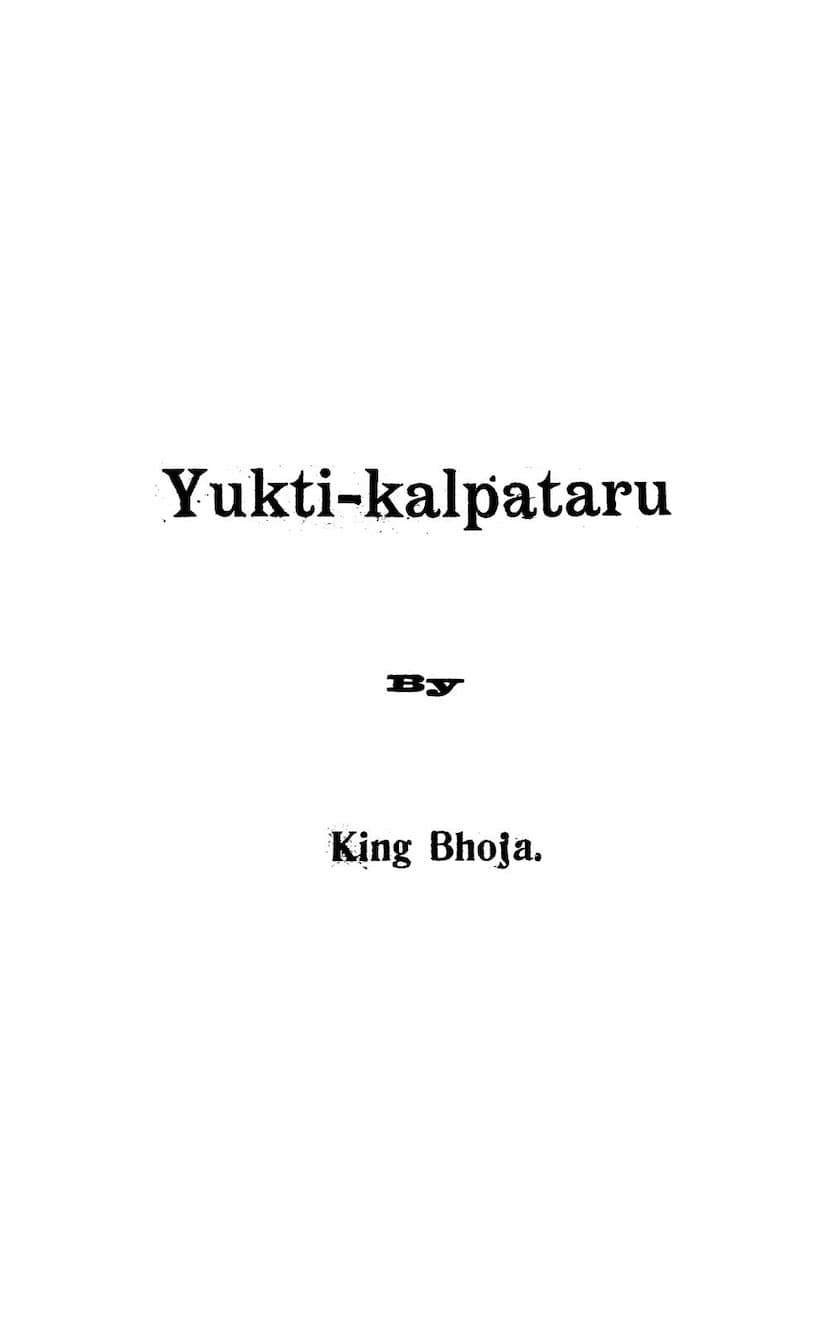Yuktikalptaru
Added to library: September 2, 2025

Summary
Here is a comprehensive summary of the Jain text "Yuktikalpataru" by King Bhoja, based on the provided catalog link and the text excerpts:
Title: Yukti-kalpataru (युक्तिकल्पतरुः) Author: King Bhoja (महाराज श्रीभोज) Publisher: Shardacharan Kavyavinod, Kolkata Editor: Pandit Isvara Chandra Sastri Foreword: Narendra Nath Law (August, 1917)
Overview:
The Yukti-kalpataru (Jewel-Tree of Reason) is a significant work attributed to the renowned Paramara king Bhoja of Dhara, believed to have lived in the 11th century CE. This comprehensive compilation, edited and published by Pandit Isvara Chandra Sastri, is a treasure trove of information on a wide array of secular and practical subjects related to early Hindu civilization. As noted in the foreword by Narendra Nath Law, the text aims to shed light on aspects of Hindu life that were previously obscure due to the difficulty in accessing original manuscripts and the challenges of dealing with unedited texts.
Key Subjects Covered:
The Yukti-kalpataru is a multi-disciplinary text that delves into various aspects of governance, material culture, and daily life. The provided excerpts, particularly the Table of Contents (विषयसूची), reveal a vast range of topics:
- Polity and Statecraft (नीति-युक्तिः): This forms a substantial part of the work, discussing the qualifications and roles of various state officials like the Guru (teacher/preceptor), Purohita (priest), Mantri (minister), Duta (envoy), Lekhaka (scribe), Jyotirvid (astrologer/astronomer), Puradhayksha (head of the city/fort), Baladhyaksha (commander of forces), and Ayudhadhyaksha (master of arms). It details their examinations, duties, and the importance of their roles in a well-functioning kingdom.
- Diplomacy and Warfare: The text covers topics like envoys (दूत), their qualifications and types, peace treaties (सन्धि), strategic positioning (आसन), the art of alliance (वैधम्), seeking refuge (आश्रय), and the application of punishment (दण्ड). It also discusses the strategies and tactics of warfare, including the importance of fortifications (इन्द-युक्तिः), different types of fortifications (natural and artificial), and their construction.
- Urban Planning and Architecture (वास्तु-युक्तिः): A significant portion of the book is dedicated to the principles of town and building construction. This includes the selection of appropriate sites, the planning of cities, determining directions (दिङ्-नर्णयः), the layout of houses and palaces, the construction of walls (प्राचीर), gates (द्वार), and various types of residences and halls (आसन, पीठ, वितान, गृह). It also specifies auspicious times for construction and entry (काल-निर्णयः, प्रवेश-कालः) and discusses the specific qualities and placement of different structures within a complex.
- Material Culture and Arts: The Yukti-kalpataru provides detailed descriptions of various articles of furniture, such as different types of seats (खट्टा, पीठ, पर्यङ्क), their materials, dimensions, and auspicious attributes. It also covers decorative elements and ornaments (अलङ्कार-युक्तिः), including the selection, testing, and valuation of precious stones like diamonds (वज्र), rubies (पद्मराग), emeralds (मरकत), sapphires (इन्द्रनील), pearls (मुक्ता), and others.
- Weaponry and Arms (अस्त्र-युक्तिः): The text offers a comprehensive guide to various weapons, including swords (खड्ग), their types, characteristics, testing methods, and the significance of their features (अङ्ग, रूप, जाति, नेत्र, अरिष्ट). It also discusses shields (चर्म), bows (धनु), arrows (बाण), and other military equipment.
- Animal Husbandry and Transport (हय, गज, वृष, मृग, सारमेय, महिष, अजादि परीक्षा): A considerable section is dedicated to the study and management of animals, particularly horses and elephants. It details their characteristics, types, testing methods, auspicious and inauspicious signs, care, and the appropriate times for their use or training. The text also briefly touches upon other animals like bulls, deer, dogs, and buffaloes.
- Vehicles (यान-युक्तिः): The book describes various types of conveyances, including those drawn by animals (चतुष्पदयान), carried by humans (द्विपदयाम), and watercraft (निष्पदयान). It specifies their construction, materials, dimensions, and auspiciousness for travel.
- Household Items and Rituals: Beyond major constructions, it discusses items like chhatra (umbrellas), dhvaja (flags), chamara (fly-whisks), bhringara (vessels for sprinkling water), chashaka (cups), and the proper use of ornaments and decorative items. It also touches upon the ritualistic aspects of consecration and consecrating objects.
Attribution and Authorship:
The foreword and the text itself clearly attribute the work to King Bhoja of Dhara. The preface by Pandit Isvara Chandra Sastri, as mentioned in the foreword, supports the 11th century CE as the likely period of composition. The text was compiled by collating three manuscripts, one of which was an old transcript of the copy used by Dr. Rajendralala Mitra.
Significance:
The Yukti-kalpataru is invaluable for understanding the practical knowledge, artistic skills, and governance principles prevalent in medieval India. Its detailed descriptions of architecture, metallurgy, gemology, and statecraft provide a rich historical and cultural insight. The inclusion of subjects like ship-building is particularly noteworthy for its rarity in similar contemporary texts. The work is a testament to the intellectual and material advancements of the period and the encyclopedic interests of King Bhoja.
In essence, the Yukti-kalpataru is a comprehensive encyclopedic treatise on secular knowledge, offering practical guidance on statecraft, urban planning, material objects, military science, and animal husbandry, all attributed to the prolific King Bhoja.